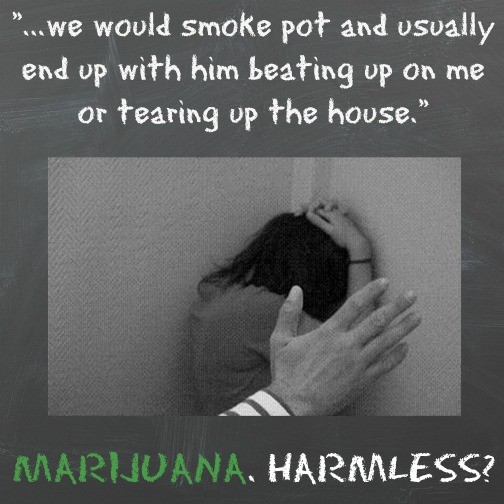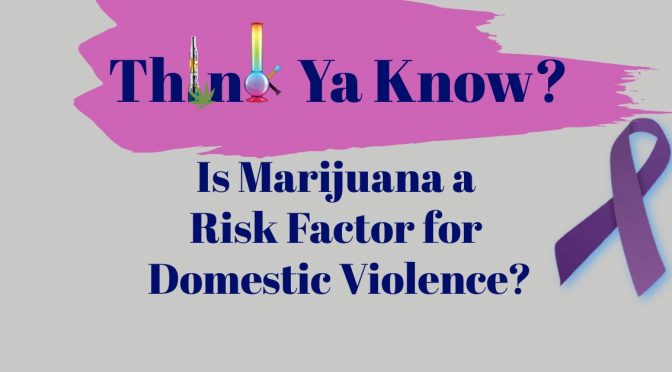*Reader discretion is advised, content describes details of violent crimes.
October is Domestic Violence Awareness month. Despite the public perception of pot users being laid back and too lazy for anger, the evidence suggests otherwise. Most people perceive alcohol as the substance most often connected to domestic violence. But other drugs, like marijuana, contribute handily to the mix.
We’ve failed to stem domestic violence in the US, despite strong efforts to provide services and numerous shelters for women. Many advocates against domestic violence assert that unequal power and control are the only driving forces involved in violence. Actually, substance abusers perpetrate more than 80 percent of domestic violence, according to estimates. Some studies put the rate at 94% of domestic violence.
In the past, we’ve run many articles on the role of marijuana in domestic violence. Richard Kirk shot his wife – in front of the children — after ingesting a marijuana edible. He tried marijuana for a medical condition, back pain, although there’s scant evidence that marijuana is a solution to that problem.
A supporter of ours wrote her testimony of domestic violence that corresponded with years of pot use, between ages 17 and 31. Living in northern California, marijuana was part of the daily routine for her, her boyfriends and husband. Thankfully our writer is more than 30 years sober today. Here is part one of her three-part testimony. To quote our friend, “There was so much abuse that it is a miracle I am alive.”

How and why marijuana leads to violence
All substance abuse – marijuana as well as alcohol, cocaine and other drugs – can lead to addiction. Drug addiction causes drastic mood changes. Marijuana, classified as a hallucinogen, can cause fear, anxiety, panic or paranoia. Experiencing any of these symptoms can lead to violent behavior, endangering family, other people and property. Science proves marijuana is a causal factor that triggers psychosis, a condition that distorts reality which increase the risk for violence by 20X. When people mix pot with alcohol and other drugs, the problems intensify.
Render Stetson-Shanahan, 26, murdered his roommate and fellow Bard College graduate, Carolyn Bush, an aspiring poet, in Queens, NY. The court found that he “suffered a psychotic break due to his marijuana use on the night of the killing.” Render was an artist suffering from depression, but he didn’t seem realize that marijuana may have been fueling his depression.
On Memorial Day of 2018, Bryn Sprejcher, 27, a doctor of audiology, smoked marijuana with her boyfriend and had hallucinations. She felt extreme effects from the second hit of the bong and ended up stabbing Chad O’Melia to death in her California apartment.
John Lewis, 49, of Michigan, shot and killed his wife in his marijuana grow room. The jury found that him guilty of premeditated murder, which probably rules out psychosis.
However, marijuana is also the drug most likely to lead to permanent psychosis (schizophrenia) even after a person stops using it, as two large scale studies from Finland and Denmark reveal. The academic studies support a focus on reducing marijuana use to curb domestic violence.
Advocacy groups against gender-based violence will continue to stumble, unless they also target the substance abuse which triggers the domestic violence.
Stop Violence Against Women
“Marijuana use should be considered as a target of early intimate partner violence intervention and treatment programming.” Researchers from the University of Florida came to this conclusion, and a number of recent studies back up their findings .
What the Science Tells Us
The Relationship Between Marijuana Use and Intimate Partner Violence in a Nationally Representative, Longitudinal Sample,” by Jennifer M. Reingle, Stephanie A.S. Staras, Wesley G. Jennings, Jennifer Branchini, Mildred M. Maldonado-Molina, Journal of Interpersonal Violence, May, 2012. (Consistent use of marijuana during adolescence was predictive of committing intimate partner violence in early adulthood and being a victim, 2 x more likely. Sample of 9,400). Prior studies found marijuana use was predictive of physical assault by their intimate partners (Moore et al., 2008; Nabors, 2010; Railford , 2007).
Effects of marijuana use on impulsivity and hostility in daily life, by Emily B. Ansell, Holly B. Laws, Michael J. Roche, Rajita Sinha, Drug and Alcohol Dependence, 148 (2015) 136-142. January 6, 2015. (A Study of 43 subjects found marijuana, but not alcohol, use increased interpersonal hostility and impulsivity in daily life. The events occurred on day of use and the next day. )
Violent Behavior as Related to Marijuana and Other Drugs, by Albert Friedman, Kimberly Glassman, Arlene Terras, Journal of Addictive Diseases, Vol 20(1), 2001,pp. 49-72. (Marijuana users are nearly as likely to engage in violent behaviors as crack users)
Marijuana use is associated with intimate partner violence perpetration among men arrested for domestic violence. Ryan C. Shorey, Ellen Haynes, Meagan Brem, Autumn Rae Florimbio, Hannah Grigorian, and Gregory L. Stuart, Translational Issues in Psychological Science 4, no. 1, 2018, 108–118. Findings demonstrated marijuana use is associated with psychological, physical, and sexual violence, a link is separate from other known factors. The conclusion stated, “Treatment of men arrested for domestic violence should consider reducing marijuana.”
Listen to this video to hear how one woman entered into a relationship unaware that marijuana would soon change the man she chose to be with. In the end, he even employs his own children to help stalk her.
Marijuana is a risk factor in VIOLENCE against whole families
Interesting Facts from News Reports
Last year several incidences of adult children turning on their families, killing both mother and father, hit the news. Camden Nicholson, age 27, allegedly killed his parents and their housekeeper in a gated community of Newport Beach, California, on February 13-14, 2019. According to investigators, Nicholson smoked excessive amounts of marijuana, and had caused great fear in his family.
Just a month earlier, Dakota Theriot, 22, killed his family in Louisiana, his girlfriend and his girlfriend’s parents in a murder spree. He had been a marijuana smoker since middle school.
Also in January, 2019, Mark Gregory Gago of Oregon bludgeoned four family members to death with an axe, including his 9-month old daughter. Two people were able to escape from Gago, his wife’s daughter, 8, and another roommate. Like Kevin Janson Neal of California, who killed his wife and buried her body under the floor, Gregory Gago was a pot farmer.
Kevin Janson Neal’s family admitted to the public of his long-time pot use and mental health problems. As for Neal, he went on a shooting spree, killing five people , injuring others and attempting to harm students as he shot bullets at an elementary school.
Orion Krause, 22, Maine, murdered his parents, grandmother and grandmother’s caretaker. It was completely out of character for the gentle musician who graduated from Oberlin College.
Teens and Young Men
Acts of violence against parents, siblings exemplify what pot can do to families.
Ashton Sacks, a 19-year-old who lived in Washington allegedly drove 1200 miles to southern California to shoot his parents and other family members. Before that time, Ashton was wasting away his days, continually smoking marijuana and playing a particular video game..
Malik Murphy, 20, Colorado Springs, murdered his brother, Noah, 7 and his sister, Sophia, 5, as the family was sleeping, and tried to kill the parents, too. His troubles began at age 16, when he was found to be smoking marijuana from a “pen” in his backpack.
Davie Dauzat, 24, Texas, killed his wife in front of the children, after they smoked pot together. He told police he had used drugs earlier that day, and the only drug was found to be marijuana.
John Granat, 17, of Palos Hills, IL , along with his friends, murdered his parents. The anger and revenge began when his father grounded him for finding marijuana.
Kamil Dantes, 29, Great Britain- murdered his parents with a knife in 2015. At the sentencing, Justice Charles Haddon-Cave said: “Your deteriorating mental health had much to do with your history of drug use and in particular your cannabis habit. This is another example of the danger of cannabis use and its ability to induce psychotic behaviour in young men.”
Our previous blogs
In 2017, our blog was, “Let’s tackle substances abuse during domestic violence awareness month.”
In 2016, we wrote about pot’s downside in domestic violence, and our 2015 article describes in detail three domestic violence cases involving marijuana that ended in tragedy that year.
As a nation, we are turning a blind eye to the damage marijuana users may present to women and children. For the most part, the marijuana defense does not come out in criminal trials, even though marijuana’s triggering effects on psychosis are known to the psychiatric community. “I don’t think any serious researcher or psychiatrist would now dispute that cannabis consumption is a component cause of psychosis,” said renown psychiatrist Sir Dr. Robin Murray, King’s College, London.
We need to stop underestimating the poor judgment, the violence and warped sense of time common to many marijuana users, including women. Women who have been long-time users accept men who are violent in their lives, because they disassociate and use pot to numb the pain.
Widespread mental health issues will also continue to grow in America, as long as we fail to acknowledge the cannabis connection. When substance abusers lose control over their lives, lashing out is their futile way of trying to regain the power they lost because of drugs and/or alcohol in their lives. If advocates against domestic violence submit to the theory that only unequal power is the cause of domestic violence, we won’t make progress.
ACTIONS
If you or someone you know may be involved in a domestic violence situation:
- The site TheHotline.org provides hotline numbers, confidential help and safety plans, help in recognizing what abuse looks like as well as what a relationship should look like, instructions to clear web browsers and “quick escape” when on their site.
- National Hotline: 1(800)799-SAFE (7233), Twitter (@ndvh), and Facebook (National Domestic Violence Hotline)
- Check out Robin McGraw and Dr. Phil’s site, When Georgia Smiled
- Share this Think Ya Know? and these actions with anyone you know who may work at shelters, food banks, or other services that domestic abuse victims may frequent.


